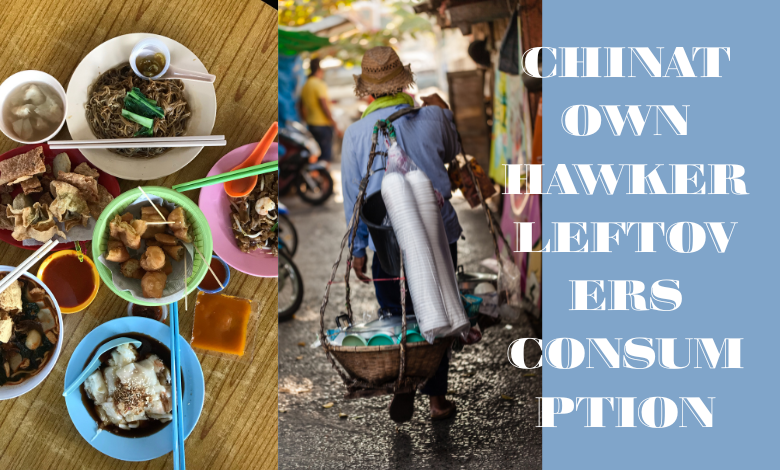Chinatown Hawker Leftovers Consumption: A Sustainable Solution to Food Waste

Imagine strolling through the lively streets of Chinatown on a warm evening. The air is filled with the mouthwatering smells of sizzling meats, spicy noodles, and sweet pastries. Hawker centers those bustling food courts packed with colorful stalls are alive with chatter and the clinking of plates. People from all walks of life dig into affordable, delicious meals like dumplings, fried rice, and grilled satay. It’s a food lover’s paradise.
But as the night winds down, something less cheerful happens. Behind the stalls, hawkers are left with trays of unsold food dishes that are still perfectly good to eat but didn’t find a taker. In many places, this food would end up in the trash. Not here, though. In Chinatown’s hawker centers, people are finding clever ways to tackle this problem through leftovers consumption. It’s a simple idea with a big impact, and it’s changing the way we think about food waste.
In this article, we’ll dive into what Chinatown hawker leftovers consumption is all about. We’ll explore why hawker centers matter, how food waste became a challenge, and how consuming leftovers is helping the environment, the community, and even people’s wallets. Plus, we’ll look at some cool initiatives making a difference and what the future might hold. Whether you’re a foodie, an eco-warrior, or just curious, this is a story worth digging into. Let’s get started!
What Are Hawker Centers?
First things first what exactly are hawker centers? If you’ve never been to one, picture an open-air food court buzzing with energy. These places are a big deal in Asian cities like Singapore, Malaysia, and Hong Kong, and they’re the heart of Chinatown’s food scene. Rows of small stalls line up side by side, each run by a hawker (that’s what they call the cooks and vendors) who’s a master of their craft.
You can grab a plate of anything here think juicy roast duck, spicy laksa soup, crispy spring rolls, or even a sweet mango dessert. The food is fresh, fast, and cheap, making it a go-to spot for locals, workers, and tourists. But it’s not just about the food. Hawker centers are where people connect. Families share meals, friends catch up, and strangers swap stories over steaming bowls. It’s a slice of Chinatown’s soul, blending cultures and flavors into something special.
Hawker centers have been around for decades, growing out of street food traditions. They’re a mix of Chinese, Malay, Indian, and other influences, reflecting the diversity of the people who call Chinatown home. Whether you’re craving a hearty noodle dish or a light snack, there’s something for everyone. That’s why these places are so loved and why what happens to their leftovers matters.
The Problem of Food Waste in Hawker Centers
Now, let’s talk about the not-so-tasty side of things: food waste. Hawker centers are amazing, but they’ve got a challenge. Because they serve so many people and cook in big batches, they often end up with extra food at the end of the day. Maybe a stall made too much rice, or some customers didn’t finish their plates. Whatever the reason, that leftover food can pile up.
How big is this problem? Well, in a place like Singapore (where many Chinatown hawker centers thrive), over 744,000 tons of food waste were thrown out in 2019, according to the National Environment Agency. That’s a lot of food enough to fill hundreds of trucks! Hawker centers are a big part of that number because they’re so popular and busy.
When this food gets tossed, it’s not just a shame it’s a problem. Here’s why:
- Environment: Food in landfills rots and releases methane, a gas that heats up the planet way more than carbon dioxide. It’s bad news for climate change.
- Money: Hawkers lose cash when food goes unsold. Ingredients, time, and energy all go down the drain.
- Resources: Growing, cooking, and moving food takes water, fuel, and land. Wasting it means wasting all that effort.
In Chinatown, where life moves fast and costs are high, throwing away food hurts both the planet and the people. But here’s the good part: folks are fighting back with sustainable eating practices like consuming leftovers.
What Is Chinatown Hawker Leftovers Consumption?
So, what’s this leftovers consumption thing all about? It’s pretty simple, really. It’s the idea of using up food that might otherwise get thrown out. In Chinatown’s hawker centers, this happens in a few cool ways:
- Taking Leftovers Home: Ever had too much food on your plate? Instead of leaving it, lots of customers now take their leftovers home in a box. It’s an easy way to enjoy round two later.
- Hawkers Getting Creative: Some hawkers don’t let unsold food go to waste. They might turn leftover veggies into a soup or make fried rice from extra grains. Others sell it cheap at the end of the day.
- Sharing with the Community: Groups step in to collect surplus food and give it to people who need it—like families on tight budgets or folks without homes.
This isn’t just about saving food. It’s about food waste reduction and making the most of what’s already there. It’s practical, smart, and good for everyone involved.
Cultural and Economic Aspects of Leftover Consumption
Here’s where it gets interesting: consuming leftovers isn’t just a new trend it’s tied to deep cultural roots and real economic perks.
The Cultural Side
In many Asian cultures, wasting food is a big no-no. Think about it your grandma might’ve told you to finish every bite because “food is a blessing.” That idea runs strong in Chinatown. People here value resourcefulness and hate seeing good stuff go to waste. Consuming leftovers fits right into that mindset. It’s about respect—for the food, the farmers who grew it, and the hawkers who cooked it.
For some, it’s also a point of pride. Turning leftovers into a meal shows creativity and care. There’s no shame in it; it’s just smart living.
The Economic Side
Money talks, too. For hawkers, reducing waste means saving cash. If they can sell or reuse unsold food, they don’t lose out on the ingredients they paid for. In a tough business where every dollar counts, that’s huge.
For customers, it’s a win, too. Grabbing discounted leftovers or taking home extras means tasty food at a lower cost. And when surplus food gets shared with the community, it helps people who might not afford a hawker meal otherwise. It’s a cycle of good—less waste, more savings, and stronger ties.
Environmental Benefits of Reducing Food Waste
Let’s zoom out for a sec. Why does this matter for the planet? Reducing food waste through leftovers consumption has some serious green perks:
- Less Trash, Less Gas: When food stays out of landfills, it doesn’t rot and pump out methane. That’s a big deal for slowing down climate change.
- Saving Resources: Growing food takes water, energy, and land. Eating leftovers means we’re not wasting all that hard work.
- Easier Waste Management: Less food trash means less strain on garbage systems, which saves money and space.
In a busy place like Chinatown, where every bit of space and resource counts, these benefits add up fast. It’s a small change with a big ripple effect.
Community Initiatives and Solutions
People in Chinatown aren’t just sitting around they’re taking action. Here are some awesome community initiatives for food waste that are making waves:
- Food Bank Singapore: This group collects extra food from hawker stalls and gets it to charities, soup kitchens, and families who need it. They’ve saved tons of meals from the trash.
- Happy Hour Deals: Some hawkers offer discounts on unsold food late in the day. It’s a win-win customers get cheap eats, and hawkers clear their stock.
- Education Campaigns: Local groups teach hawkers and diners how to cut waste like ordering just enough or storing food right.
These efforts show how teamwork can turn a problem into a solution. It’s not just about food; it’s about building a stronger, greener community.
The Future of Leftover Consumption in Chinatown
What’s next for Chinatown hawker leftovers consumption? The future looks bright. As more people wake up to food waste issues, this practice could grow even bigger. Here’s what might be coming:
- Tech to the Rescue: Imagine an app that tells you which stalls have leftovers to sell cheap or connects hawkers with charities in real time. That’s already starting in some places.
- New Rules: Governments might make it easier for hawkers to donate food by tweaking safety laws, opening the door to more sharing.
- Young Ideas: The next generation is all about sustainability. They might bring fresh tricks like composting or new recipes to the table.
Hawker centers could become leaders in sustainable eating, showing the world how to blend tradition with innovation. It’s an exciting time to watch this evolve.
Conclusion: Your Turn to Join In
So, there you have it Chinatown hawker leftovers consumption is more than a quick fix. It’s a story of culture, smarts, and caring for the planet. By using up leftovers, hawkers and diners are cutting waste, saving money, and keeping their community strong. It’s a tasty way to make a difference.
But it’s not just up to them. You can jump in, too! Next time you’re at a hawker center, take your leftovers home. Support stalls that sell unsold food cheap. Or spread the word about food waste reduction. Little steps like these add up.

